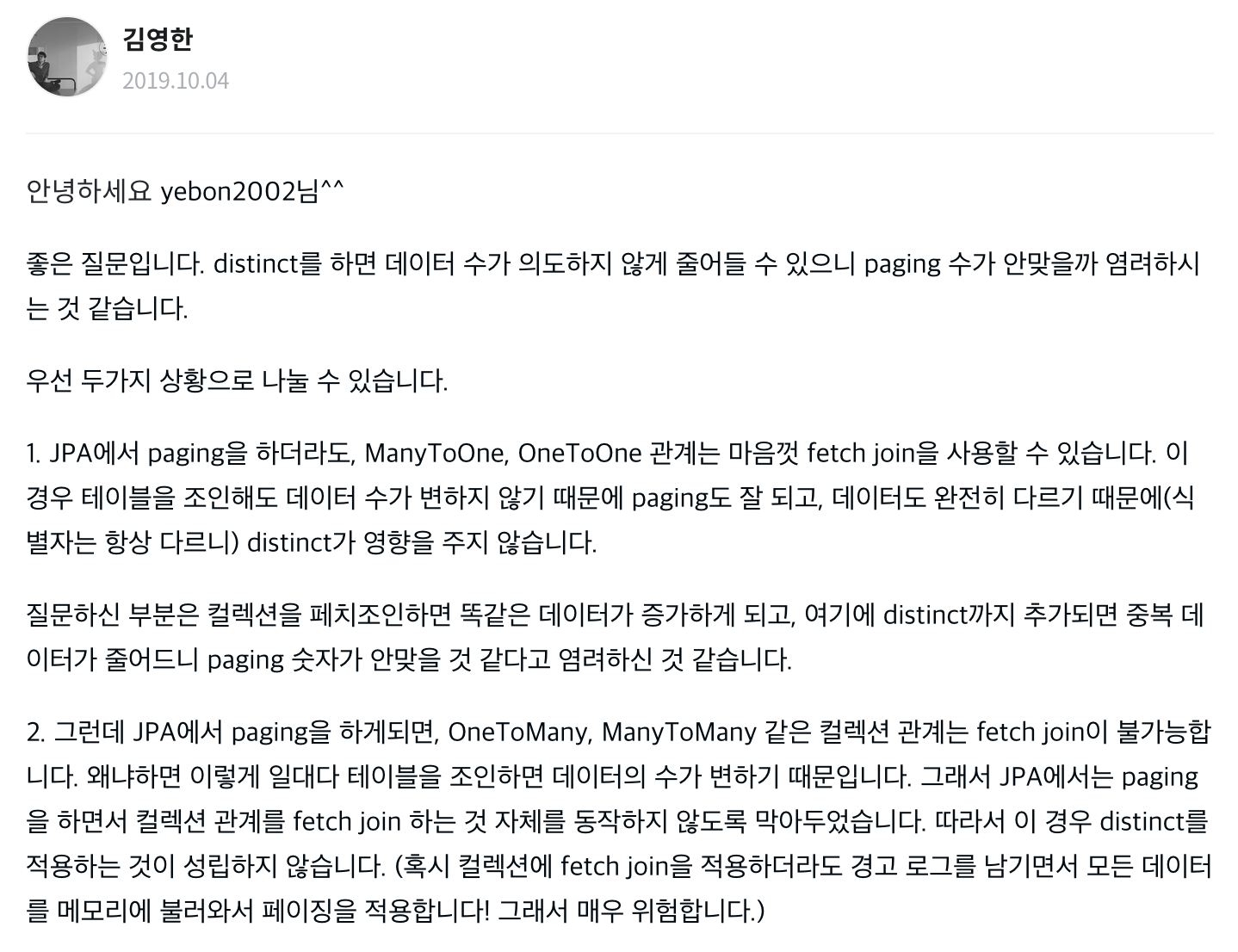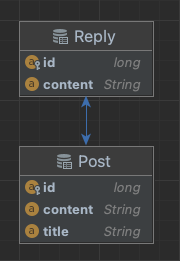JPA Fetch 조인(join)과 페이징(paging) 처리
👉 해당 포스트를 읽는데 도움을 줍니다.
0. 들어가면서
JPA N+1 Problem 포스트에선 JPA를 사용할 때 발생하는 N+1 문제와 이를 해결하기 위한 방법을 다뤘습니다.
이번엔 N+1 문제의 해결 방법인 fetch 조인(join)과 페이징(paging) 처리를 동시에 하면 발생하는 문제에 대해 알아보고 해결법을 정리하였습니다.
1. fetch 조인(join)시 페이징(paging) 처리 문제
JPA는 Pageable 인터페이스를 통해 쉬운 페이징 처리 기능을 제공합니다. 하지만 N+1 문제 회피를 위해 사용하는 fetch 조인과 함께 사용한다면 문제가 될 수 있습니다.
1.1. 문제 발생 상황
Post 엔티티와 Reply 엔티티는 일대다 관계를 가집니다. 코드와 ERD(Entity Relationship Diagram)을 먼저 살펴보도록 하겠습니다.
Post 엔티티
package blog.in.action.post;
import blog.in.action.reply.Reply;
import lombok.*;
import javax.persistence.*;
import java.util.ArrayList;
import java.util.List;
@Builder
@Getter
@Setter
@AllArgsConstructor
@NoArgsConstructor
@Entity
public class Post {
@Id
@GeneratedValue(strategy = GenerationType.AUTO)
private long id;
@Column
private String title;
@Column
private String content;
@OneToMany(mappedBy = "post")
private List<Reply> replies;
public void addReply(Reply reply) {
if (replies == null) {
replies = new ArrayList<>();
}
replies.add(reply);
}
}
Reply 엔티티
package blog.in.action.reply;
import blog.in.action.post.Post;
import lombok.*;
import javax.persistence.*;
@Builder
@Getter
@Setter
@AllArgsConstructor
@NoArgsConstructor
@Entity
public class Reply {
@Id
@GeneratedValue(strategy = GenerationType.AUTO)
private long id;
@Column
private String content;
@ManyToOne
@JoinColumn(name = "post_id")
private Post post;
}
엔티티 관계 다이어그램 (ERD, Entity Relationship Diagram)
1.2. 문제 상황 확인
간단한 테스트 코드를 통해 문제 상황을 확인해보겠습니다.
1.2.1. 테스트 코드
package blog.in.action.post;
import blog.in.action.reply.Reply;
import org.junit.jupiter.api.BeforeEach;
import org.junit.jupiter.api.Test;
import org.springframework.beans.factory.annotation.Autowired;
import org.springframework.boot.test.autoconfigure.orm.jpa.DataJpaTest;
import org.springframework.data.domain.Page;
import org.springframework.data.domain.PageRequest;
import org.springframework.data.domain.Pageable;
import javax.persistence.EntityManager;
import java.util.List;
import java.util.Set;
import java.util.stream.Collectors;
import static org.assertj.core.api.Assertions.assertThat;
@DataJpaTest
public class PostRepositoryTest {
@Autowired
private EntityManager em;
@Autowired
private PostRepository postRepository;
Post getPost(String title, String content) {
return Post.builder()
.title(title)
.content(content)
.build();
}
void insertReply(Post post, String content) {
for (int index = 0; index < 10; index++) {
Reply reply = Reply.builder()
.content(content + index)
.post(post)
.build();
post.addReply(reply);
em.persist(reply);
}
}
@BeforeEach
public void setup() {
for (int index = 0; index < 10; index++) {
Post post = getPost(index + " post", "this is the " + index + " post.");
postRepository.save(post);
insertReply(post, index + "-reply-");
}
em.flush();
em.clear();
}
@Test
public void whenFindByContentLikeFetchJoin_thenOutOfMemoryWarningMessage() {
Pageable pageable = PageRequest.of(1, 5);
Page<Post> postPage = postRepository.findByContentLikeFetchJoin("post", pageable);
List<Post> posts = postPage.getContent();
Set<Reply> replies = posts.stream()
.map(post -> post.getReplies())
.flatMap(repliesStream -> repliesStream.stream())
.collect(Collectors.toSet());
assertThat(replies.size()).isEqualTo(50);
}
}
1.2.2. 구현 코드
findByContentLikeFetchJoin메소드- fetch 조인 처리를 수행합니다.
- Pageable 객체를 통해 페이징 처리를 수행합니다.
- 페이징 처리된 결과를 반환합니다.
package blog.in.action.post;
import org.springframework.data.domain.Page;
import org.springframework.data.domain.Pageable;
import org.springframework.data.jpa.repository.JpaRepository;
import org.springframework.data.jpa.repository.Query;
public interface PostRepository extends JpaRepository<Post, Long> {
@Query(value = "SELECT DISTINCT p FROM Post p JOIN FETCH p.replies WHERE p.content LIKE %:content%",
countQuery = "SELECT COUNT(DISTINCT p) FROM Post p INNER JOIN p.replies WHERE p.content LIKE %:content%")
Page<Post> findByContentLikeFetchJoin(String content, Pageable pageable);
}
1.2.4. 경고 메시지 및 수행 쿼리
경고 메시지
- 쿼리 수행 결과를 모두 어플리케이션 메모리에 올려서 페이징 처리를 수행했다는 의미입니다.
- OOM(Out Of Memory) 문제를 유발할 수 있으므로 치명적입니다.
2022-01-16 12:37:18.309 WARN 39536 --- [ main] o.h.h.internal.ast.QueryTranslatorImpl : HHH000104: firstResult/maxResults specified with collection fetch; applying in memory!
수행 쿼리
- 실제 수행 쿼리를 보면
limit,rownum같은 키워드 없이 데이터를 조회합니다. - 조회 조건에 매칭되는 결과가 10만 건이면 모두 어플리케이션 메모리에 올리게 됩니다.
select distinct post0_.id as id1_0_0_,
replies1_.id as id1_1_1_,
post0_.content as content2_0_0_,
post0_.title as title3_0_0_,
replies1_.content as content2_1_1_,
replies1_.post_id as post_id3_1_1_,
replies1_.post_id as post_id3_1_0__,
replies1_.id as id1_1_0__
from post post0_ inner join reply replies1_ on post0_.id = replies1_.post_id
where post0_.content like ?
2. 문제 해결 방법
2.1. 기본 페이징 처리 및 default_batch_fetch_size 설정 사용
@OneToMany 애너테이션으로 관계가 맺어져 있는 경우 조인과 페이징 처리를 동시에 처리하기 어려웠습니다.
join fetch를 inner join으로 변경하더라도 페이징 처리는 되지만, 지연 로딩(lazy loading)으로 N+1 문제가 다시 발생합니다.
그래서 해결 방법으로 조인을 제거하였습니다.
일반적은 페이징 처리 후 발생하는 N+1 문제는 default_batch_fetch_size 설정을 통해 해결하였습니다.
관련된 설정은 application.yml 파일에 추가하면 됩니다.
application.yml 설정 추가
spring:
jpa:
properties:
hibernate:
default_batch_fetch_size: 1000
2.2. 테스트 코드
package blog.in.action.post;
import blog.in.action.reply.Reply;
import org.junit.jupiter.api.BeforeEach;
import org.junit.jupiter.api.Test;
import org.springframework.beans.factory.annotation.Autowired;
import org.springframework.boot.test.autoconfigure.orm.jpa.DataJpaTest;
import org.springframework.data.domain.Page;
import org.springframework.data.domain.PageRequest;
import org.springframework.data.domain.Pageable;
import javax.persistence.EntityManager;
import java.util.List;
import java.util.Set;
import java.util.stream.Collectors;
import static org.assertj.core.api.Assertions.assertThat;
@DataJpaTest(
properties = {"spring.jpa.properties.hibernate.default_batch_fetch_size=1000"}
)
public class PostRepositoryTest {
@Autowired
private EntityManager em;
@Autowired
private PostRepository postRepository;
Post getPost(String title, String content) {
return Post.builder()
.title(title)
.content(content)
.build();
}
void insertReply(Post post, String content) {
for (int index = 0; index < 10; index++) {
Reply reply = Reply.builder()
.content(content + index)
.post(post)
.build();
post.addReply(reply);
em.persist(reply);
}
}
@BeforeEach
public void setup() {
for (int index = 0; index < 10; index++) {
Post post = getPost(index + " post", "this is the " + index + " post.");
postRepository.save(post);
insertReply(post, index + "-reply-");
}
em.flush();
em.clear();
}
@Test
public void whenFindByContentLike_thenPagingWithInQuery() {
Pageable pageable = PageRequest.of(1, 5);
Page<Post> postPage = postRepository.findByContentLike("post", pageable);
List<Post> posts = postPage.getContent();
Set<Reply> replies = posts.stream()
.map(post -> post.getReplies())
.flatMap(repliesStream -> repliesStream.stream())
.collect(Collectors.toSet());
assertThat(replies.size()).isEqualTo(50);
}
}
2.3. 구현 코드
package blog.in.action.post;
import org.springframework.data.domain.Page;
import org.springframework.data.domain.Pageable;
import org.springframework.data.jpa.repository.EntityGraph;
import org.springframework.data.jpa.repository.JpaRepository;
import org.springframework.data.jpa.repository.Query;
public interface PostRepository extends JpaRepository<Post, Long> {
@Query(value = "SELECT p FROM Post p WHERE p.content LIKE %:content%",
countQuery = "SELECT COUNT(p) FROM Post p WHERE p.content LIKE %:content%")
Page<Post> findByContentLike(String content, Pageable pageable);
}
2.4. 결과 쿼리
- 쿼리 수행시
limit,offset으로 페이징 처리합니다. - 지연 로딩으로 인한 N+1 문제는 default_batch_fetch_size 설정으로
in (...)처리합니다.
-- limit, offset 쿼리
select post0_.id as id1_0_, post0_.content as content2_0_, post0_.title as title3_0_
from post post0_
where post0_.content like ?
limit ? offset ?
-- count 쿼리
select count(post0_.id) as col_0_0_
from post post0_
where post0_.content like ?
-- default_batch_fetch_size 설정을 통해 N+1 문제를 IN 쿼리로 변경
select replies0_.post_id as post_id3_1_1_,
replies0_.id as id1_1_1_,
replies0_.id as id1_1_0_,
replies0_.content as content2_1_0_,
replies0_.post_id as post_id3_1_0_
from reply replies0_
where replies0_.post_id in (?, ?, ?, ?, ?)
3. 그 외 관련 테스트 사항
@OneToMany, @ManyToOne 애너테이션에 따라 페이징 방식과 결과가 다른 것 같습니다.
일부 엔티티 관계를 고려하지 않은 테스트 코드들이 섞여 있는 것으로 보입니다.
참고한 내용들을 보면 한 눈에 확인하기 어려운 것 같아서 관련된 테스트 결과를 정리하였습니다.
3.1. @OneToMany 애너테이션과 일반 조인 사용
- 쿼리에서 distnict 처리가 필요합니다.
- 쿼리에서 limit, offset 처리를 수행합니다.
- 지연 로딩 발생으로 인해 N+1 문제를 default_batch_fetch_size 설정으로 처리할 필요가 있습니다.
3.1.1. 테스트 코드
@Test
public void whenFindByContentLikeInnerJoin_thenSeeLimitKeywordButNPlusOne() {
Pageable pageable = PageRequest.of(1, 5);
Page<Post> postPage = postRepository.findByContentLikeInnerJoin("post", pageable);
List<Post> posts = postPage.getContent();
Set<Reply> replies = posts.stream()
.map(post -> post.getReplies())
.flatMap(repliesStream -> repliesStream.stream())
.collect(Collectors.toSet());
assertThat(replies.size()).isEqualTo(50);
}
3.1.2. 구현 코드
public interface PostRepository extends JpaRepository<Post, Long> {
@Query(value = "SELECT DISTINCT p FROM Post p INNER JOIN p.replies WHERE p.content LIKE %:content%",
countQuery = "SELECT COUNT(DISTINCT p) FROM Post p INNER JOIN p.replies WHERE p.content LIKE %:content%")
Page<Post> findByContentLikeInnerJoin(String content, Pageable pageable);
}
3.1.3. SQL 로그
-- limit, offset 쿼리
select distinct post0_.id as id1_0_,
post0_.content as content2_0_,
post0_.title as title3_0_
from post post0_
inner join reply replies1_ on post0_.id = replies1_.post_id
where post0_.content like ?
limit ? offset ?
-- count 쿼리
select count(distinct post0_.id) as col_0_0_
from post post0_
inner join reply replies1_ on post0_.id = replies1_.post_id
where post0_.content like ?
-- default_batch_fetch_size 설정을 통해 N+1 문제를 IN 쿼리로 변경
select replies0_.post_id as post_id3_1_1_,
replies0_.id as id1_1_1_,
replies0_.id as id1_1_0_,
replies0_.content as content2_1_0_,
replies0_.post_id as post_id3_1_0_
from reply replies0_
where replies0_.post_id in (?, ?, ?, ?, ?)
3.2. @OneToMany 애너테이션과 @EntityGraph 애너테이션 사용
- OOM 경고 메시지가 출력됩니다.
- HHH000104: firstResult/maxResults specified with collection fetch; applying in memory!
- 쿼리에서 limit, offset 처리를 미수행합니다.
3.2.1. 테스트 코드
@Test
public void whenFindByContentLikeEntityGraph_thenPagingWithInQuery() {
Pageable pageable = PageRequest.of(1, 5);
Page<Post> postPage = postRepository.findByContentLikeEntityGraph("post", pageable);
List<Post> posts = postPage.getContent();
Set<Reply> replies = posts.stream()
.map(post -> post.getReplies())
.flatMap(repliesStream -> repliesStream.stream())
.collect(Collectors.toSet());
assertThat(replies.size()).isEqualTo(50);
}
3.2.2. 구현 코드
public interface PostRepository extends JpaRepository<Post, Long> {
@EntityGraph(attributePaths = {"replies"})
@Query(value = "SELECT p FROM Post p WHERE p.content LIKE %:content%",
countQuery = "SELECT COUNT(p) FROM Post p WHERE p.content LIKE %:content%")
Page<Post> findByContentLikeEntityGraph(String content, Pageable pageable);
}
3.2.3. SQL 로그
-- limit, offset 처리되지 않은 쿼리
select post0_.id as id1_0_0_,
replies1_.id as id1_1_1_,
post0_.content as content2_0_0_,
post0_.title as title3_0_0_,
replies1_.content as content2_1_1_,
replies1_.post_id as post_id3_1_1_,
replies1_.post_id as post_id3_1_0__,
replies1_.id as id1_1_0__
from post post0_
left outer join reply replies1_ on post0_.id = replies1_.post_id
where post0_.content like ?
-- count 쿼리
select count(post0_.id) as col_0_0_
from post post0_
where post0_.content like ?
3.3. @ManyToOne 애너테이션과 fetch 조인 사용
- 쿼리에서 limit, offset 처리를 수행합니다.
3.3.1. 테스트 코드
@Test
public void whenFindByPostIdFetchJoin_thenNothingWarning() {
Pageable pageable = PageRequest.of(1, 5);
Page<Reply> replyPage = replyRepository.findByContentLikeFetchJoin("0-reply-", pageable);
assertThat(replyPage.getContent().size()).isEqualTo(5);
}
3.3.2. 구현 코드
public interface ReplyRepository extends JpaRepository<Reply, Long> {
@Query(value = "SELECT r FROM Reply r JOIN FETCH r.post WHERE r.content LIKE %:content%",
countQuery = "SELECT COUNT(r) FROM Reply r INNER JOIN r.post WHERE r.content LIKE %:content%")
Page<Reply> findByContentLikeFetchJoin(String content, Pageable pageable);
}
3.3.3. SQL 로그
-- limit, offset, fetch 처리된 쿼리
select reply0_.id as id1_1_0_,
post1_.id as id1_0_1_,
reply0_.content as content2_1_0_,
reply0_.post_id as post_id3_1_0_,
post1_.content as content2_0_1_,
post1_.title as title3_0_1_
from reply reply0_
inner join post post1_ on reply0_.post_id = post1_.id
where reply0_.content like ?
limit ? offset ?
-- count 쿼리
select count(reply0_.id) as col_0_0_
from reply reply0_
inner join post post1_ on reply0_.post_id = post1_.id
where reply0_.content like ?
3.4. @ManyToOne 애너테이션과 일반 조인 사용
- 쿼리에서 limit, offset 처리를 수행합니다.
- fetch 조인이 아니므로 Post 엔티티 정보를 조회하지 않습니다.
- 별도 Post 엔티티 조회 쿼리를 수행합니다.
3.4.1. 테스트 코드
@Test
public void whenFindByPostIdInnerJoin_thenNothingWarning() {
Pageable pageable = PageRequest.of(1, 5);
Page<Reply> replyPage = replyRepository.findByContentLikeInnerJoin("0-reply-", pageable);
assertThat(replyPage.getContent().size()).isEqualTo(5);
}
3.4.2. 구현 코드
public interface ReplyRepository extends JpaRepository<Reply, Long> {
@Query(value = "SELECT r FROM Reply r INNER JOIN r.post WHERE r.content LIKE %:content%",
countQuery = "SELECT COUNT(r) FROM Reply r INNER JOIN r.post WHERE r.content LIKE %:content%")
Page<Reply> findByContentLikeInnerJoin(String content, Pageable pageable);
}
3.4.3. SQL 로그
-- limit, offset 쿼리
select reply0_.id as id1_1_,
reply0_.content as content2_1_,
reply0_.post_id as post_id3_1_
from reply reply0_
inner join post post1_ on reply0_.post_id = post1_.id
where reply0_.content like ?
limit ? offset ?
-- Fetch 타입 Eager로 인한 데이터 조회
select post0_.id as id1_0_0_,
post0_.content as content2_0_0_,
post0_.title as title3_0_0_
from post post0_
where post0_.id = ?
-- count 쿼리
select count(reply0_.id) as col_0_0_
from reply reply0_
inner join post post1_ on reply0_.post_id = post1_.id
where reply0_.content like ?
3.5. @ManyToOne 애너테이션과 @EntityGraph 애너테이션 사용
- 쿼리에서 limit, offset 처리를 수행합니다.
3.5.1. 테스트 코드
@Test
public void whenFindByPostIdEntityGraph_thenNothingWarning() {
Pageable pageable = PageRequest.of(1, 5);
Page<Reply> replyPage = replyRepository.findByContentLikeEntityGraph("0-reply-", pageable);
assertThat(replyPage.getContent().size()).isEqualTo(5);
}
3.5.2. 구현 코드
public interface ReplyRepository extends JpaRepository<Reply, Long> {
@EntityGraph(attributePaths = {"post"})
@Query(value = "SELECT r FROM Reply r WHERE r.content LIKE %:content%",
countQuery = "SELECT COUNT(r) FROM Reply r LEFT OUTER JOIN r.post WHERE r.content LIKE %:content%")
Page<Reply> findByContentLikeEntityGraph(String content, Pageable pageable);
}
3.6.3. SQL 로그
-- limit, offset, fetch 처리된 쿼리
select reply0_.id as id1_1_0_,
post1_.id as id1_0_1_,
reply0_.content as content2_1_0_,
reply0_.post_id as post_id3_1_0_,
post1_.content as content2_0_1_,
post1_.title as title3_0_1_
from reply reply0_
left outer join post post1_ on reply0_.post_id = post1_.id
where reply0_.content like ?
limit ? offset ?
-- count 쿼리
select count(reply0_.id) as col_0_0_
from reply reply0_
left outer join post post1_ on reply0_.post_id = post1_.id
where reply0_.content like ?
CLOSING
인프런에 김영한님이 달아주신 답변을 보면 다음과 같이 정리할 수 있습니다.
-ToOne애너테이션을 통해 형성된 관계인 경우 테이블 조인에 따라 데이터 수가 변경되지 않으므로 페이징 처리가 잘됩니다.-ToMany애너테이션을 통해 형성된 관계인 경우 테이블 조인에 따라 데이터가 변경되어 페이징 처리와 페치 조인이 동시에 불가능합니다.



댓글남기기